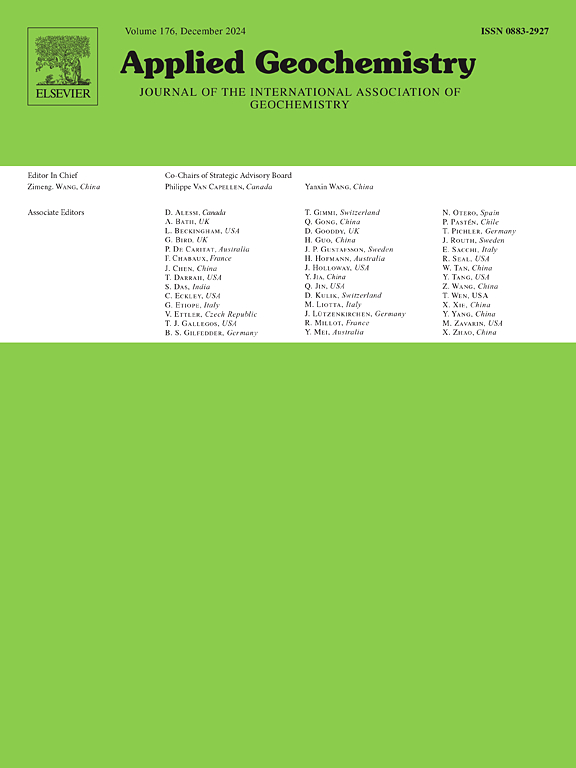Origin of composite fibrous carbonate veins in Middle Jurassic ultra-low-ash coal, Ordos Basin, China: Insights on the interaction between organic carbon and inorganic carbonates after peat burial
IF 3.4
3区 地球科学
Q1 GEOCHEMISTRY & GEOPHYSICS
引用次数: 0
Abstract
Valuable geological information on coal is contained within both the organic and inorganic constituents. Buried organic matter and precipitated carbonate minerals, as key elements of the lithospheric carbon reservoir, raise questions about whether their co-occurrence in coal is coincidental or reflects an underlying connection. Authigenic carbonate minerals in coal exhibit diverse species (e.g., siderite, calcite, and the ankerite-dolomite series) and morphologies (e.g., coal balls; nodules; and cell-, cleat- and fracture-filling forms), reflecting various formation processes during coalification. Fibrous carbonate veins in black shales consist of elongated calcite crystals with large aspect ratios (a rare calcite habit), and are associated with hydrocarbon fluid activity. However, the identification, formation mechanism, and material sources of fibrous carbonate veins within coal remains unclear. To resolve this problem, detailed petrographic, mineralogical, and geochemical analyses were conducted on the middle Jurassic No. 2(2) coal of the Ordos Basin, China, including stable isotopic analysis of carbon and oxygen in composite carbonates excluding siderite. The No. 2(2) coal seam is classified as an ultra-low-ash, super-low-sulfur, and high volatile B bituminous coal, according to the Chinese national standards GB/T 15224.1-2018, GB/T 15224.2-2021, and ASTM Standard D388-23, respectively. It contains abundant fusinite and semifusinite fragments dispersed in collodetrinite. Compared with average world coals, only Sr in the coal is slightly enriched. The carbonates in the coal (33.5 %; low temperature ash basis) consist of calcite, ankerite, and siderite. The values of δ13CVPDB and δ18OVPDB associated with composite carbonate veins (calcite and ankerite) range from −34.87 ‰ to −11.43 ‰ and from −14.66 ‰ to −10.84 ‰, respectively. Two types of high-ash yield intervals (Si-rich and Ca-rich) were identified within the low-ash coal seam. The Si-rich benches are attributed to the influx of Si–Al-rich fluids during peat accumulation. Composite carbonate veins, which formed during coalification, represent another source for inorganic matter in high-ash intervals (Ca-rich). Optical and electron microscope observations, together with carbon-oxygen isotopic analyses, indicate that overpressurised fluids from coal maturation and methane oxidation led to in situ coal fracturing, followed by the formation of composite fibrous carbonate veins and crack-seal structures in low-ash coal. Based upon these results, a model for the formation of fibrous carbonate veins within low-ash coal from the Cuijiagou mine is proposed to facilitate an understanding of the carbon transformation from organic matter to minerals after peat burial.
鄂尔多斯盆地中侏罗统超低灰煤复合纤维碳酸盐脉的成因:泥炭埋藏后有机碳与无机碳酸盐相互作用的认识
煤的有机和无机成分中都包含有价值的地质信息。埋藏有机质和沉淀碳酸盐矿物作为岩石圈碳储层的关键元素,它们在煤中的共存是巧合还是反映了一种潜在的联系。煤中的自生碳酸盐矿物表现出多种多样的种类(如菱铁矿、方解石和铁白云石系列)和形态(如煤球;结节;以及细胞型、清晰型和裂隙充填型),反映了煤化过程中不同的形成过程。黑色页岩中的纤维碳酸盐脉由长条形方解石晶体组成,具有大宽高比(一种罕见的方解石习性),与油气流体活动有关。然而,煤中碳酸盐纤维脉的识别、形成机制和物质来源仍不清楚。为了解决这一问题,本文对鄂尔多斯盆地中侏罗统2(2)煤进行了详细的岩石学、矿物学和地球化学分析,包括对不含菱铁矿的复合碳酸盐进行了碳氧稳定同位素分析。2(2)煤层分别按照中国国家标准GB/T 15224.1-2018、GB/T 15224.2-2021和ASTM标准D388-23划分为超低灰分、超低硫、高挥发分B型烟煤。它含有丰富的分散在胶质岩中的丝质和半丝质碎片。与世界平均煤相比,煤中只有Sr略有富集。煤中碳酸盐占33.5%;低温灰基)由方解石、铁白云石和菱铁矿组成。与复合碳酸盐脉(方解石和铁白云石)相关的δ13CVPDB和δ18OVPDB值分别为- 34.87‰~ - 11.43‰和- 14.66‰~ - 10.84‰。在低灰分煤层中发现了富硅和富钙两种高灰分产层。富硅阶地是泥炭堆积过程中富硅铝流体流入的结果。在煤化过程中形成的复合碳酸盐脉是高灰分层(富钙)无机物的另一来源。光学和电子显微镜观察以及碳氧同位素分析表明,煤成熟和甲烷氧化产生的超压流体导致了原位压裂,随后在低灰分煤中形成了复合纤维碳酸盐脉体和裂缝封闭结构。在此基础上,建立了翠家沟低灰分煤中碳酸盐纤维脉体的形成模型,为认识泥炭埋藏后有机质向矿物的碳转化提供了理论依据。
本文章由计算机程序翻译,如有差异,请以英文原文为准。
求助全文
约1分钟内获得全文
求助全文
来源期刊

Applied Geochemistry
地学-地球化学与地球物理
CiteScore
6.10
自引率
8.80%
发文量
272
审稿时长
65 days
期刊介绍:
Applied Geochemistry is an international journal devoted to publication of original research papers, rapid research communications and selected review papers in geochemistry and urban geochemistry which have some practical application to an aspect of human endeavour, such as the preservation of the environment, health, waste disposal and the search for resources. Papers on applications of inorganic, organic and isotope geochemistry and geochemical processes are therefore welcome provided they meet the main criterion. Spatial and temporal monitoring case studies are only of interest to our international readership if they present new ideas of broad application.
Topics covered include: (1) Environmental geochemistry (including natural and anthropogenic aspects, and protection and remediation strategies); (2) Hydrogeochemistry (surface and groundwater); (3) Medical (urban) geochemistry; (4) The search for energy resources (in particular unconventional oil and gas or emerging metal resources); (5) Energy exploitation (in particular geothermal energy and CCS); (6) Upgrading of energy and mineral resources where there is a direct geochemical application; and (7) Waste disposal, including nuclear waste disposal.
 求助内容:
求助内容: 应助结果提醒方式:
应助结果提醒方式:


